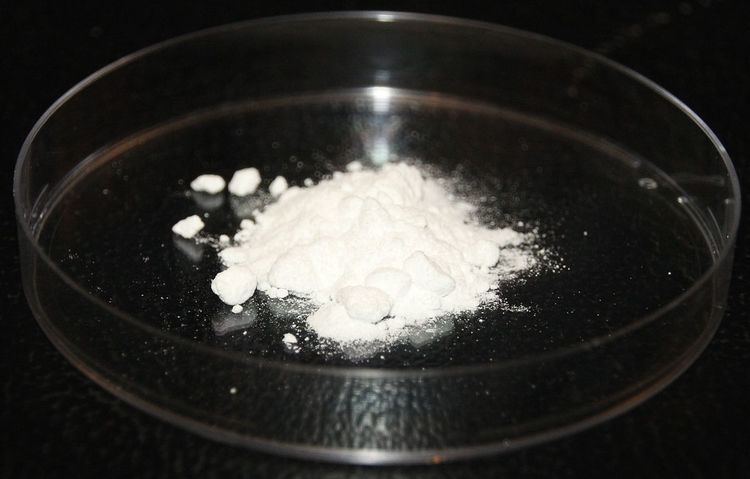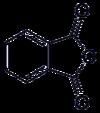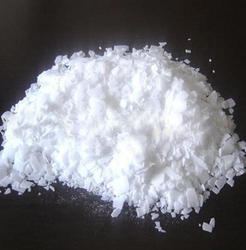Appearance white flakes Molar mass 148.1 g/mol Boiling point 295 °C | Formula C6H4(CO)2O Melting point 131 °C Density 1.53 g/cm³ | |
 | ||
Related compounds | ||
Phthalic anhydride is the organic compound with the formula C6H4(CO)2O. It is the anhydride of phthalic acid. Phthalic anhydride is a principal commercial form of phthalic acid. It was the first anhydride of a dicarboxylic acid to be used commercially. This colourless solid is an important industrial chemical, especially for the large-scale production of plasticizers for plastics. In 2000, the worldwide production volume was estimated to be about 3 million tonnes per year.
Contents
- How to make phthalic acid and phthalic anhydride
- Synthesis and production
- Uses
- Applications
- Preparation of phthalate esters
- Organic synthesis
- Preparation of aliphatic nitroalkenes
- Precursor to dyestuffs
- Pharmaceuticals
- Safety
- References

How to make phthalic acid and phthalic anhydride
Synthesis and production

Phthalic anhydride was first reported in 1836 by Auguste Laurent. More contemporary routes include catalytic oxidation of ortho-xylene and naphthalene ("Gibbs phthalic anhydride process"), although use of naphthalene has declined. Starting from o-xylene, the oxidation follows the following stoichiometry:
C6H4(CH3)2 + 3 O2 → C6H4(CO)2O + 3 H2OThe reaction proceeds with about 70% selectivity. About 10% of maleic anhydride is also produced:
C6H4(CH3)2 + 7.5 O2 → C4H2O3 +4 H2O + 4 CO2
The reaction is catalyzed by a vanadium pentoxide (V2O5) between 320 - 400 °C. The phthalic anhydride is separated from byproducts by a series of "switch condensers". Phthalic anhydride and maleic anhydride are recovered by distillation. Phthalic anhydride can also be prepared from phthalic acid:
Uses

The primary use of phthalic anhydride is as a chemical intermediate in the production of plastics from vinyl chloride. Phthalate esters, which function as plasticizers, are derived from Phthalic Anhydride. Phthalate plasticizers are used for the production of flexible PVC products such as cables, pipes and hoses, leather cloth, shoes, film for packaging etc. Phthalic anhydride has another major use in the production of polyester resins and other minor uses in the production of alkyd resins used in paints and lacquers; certain dyes (anthraquinone, phthalein, rhodamine, phthalocyanine, fluorescin, and xanthene dyes); insect repellents; and polyester polyols for polyurethanes. It is also utilized as a rubber scorch inhibitor and retarder.
Applications

Phthalic anhydride is a versatile intermediate in organic chemistry, in part because it is bifunctional and cheaply available. Hydrolysis by hot water forms ortho-phthalic acid. Hydrolysis of anhydrides is not typically a reversible process. Phthalic acid is however easily dehydrated to form phthalic anhydride. Above 180 °C, phthalic anhydride re-forms.
Preparation of phthalate esters

As with other anhydrides, the alcoholysis reaction is the basis of the manufacture of phthalate esters, which are widely used (and controversial - see endocrine disruptor) plasticizers. In the 1980s, approximately 6.5×109 kg of these esters were produced annually, and the scale of production was increasing each year, all from phthalic anhydride. The process begins with the reaction of phthalic anhydride with alcohols, giving the monoesters:
C6H4(CO)2O + ROH → C6H4(CO2H)CO2RThe second esterification is more difficult and requires removal of water:
C6H4(CO2H)CO2R + ROH ⇌ C6H4(CO2R)2 + H2OThe most important diester is bis(2-ethylhexyl) phthalate ("DEHP"), used in the manufacture of polyvinyl chloride compounds.
Organic synthesis
Phthalic anhydride is a precursor to a variety of reagents useful in organic synthesis. Important derivatives include phthalimide and its many derivatives. Chiral alcohols form half-esters (see above), and these derivatives are often resolvable because they form diastereomeric salts with chiral amines such as brucine. A related ring-opening reaction involves peroxides to give the useful peroxy acid:
C6H4(CO)2O + H2O2 → C6H4(CO3H)CO2HPreparation of aliphatic nitroalkenes
Phthalic anhydride is used to dehydrate short-chain nitro-alcohols to yield nitroalkenes, compounds with a high tendency to polymerize.
Precursor to dyestuffs
Phthalic anhydride is widely used in industry for the production of certain dyes. A well-known application of this reactivity is the preparation of the anthroquinone dye quinizarin by reaction with para-chlorophenol followed by hydrolysis of the chloride.
Pharmaceuticals
Phthalic anhydride treated with cellulose acetate gives cellulose acetate phthalate (CAP), a common enteric coating excipient that has also been shown to have antiviral activity. Phthalic anhydride is a degradation product of CAP.
Phthalic anhydride is a precursor to phthalylsulfathiazole, an antimicrobial, as well as phthalylsulfamethizole, phthalylsulfacetamide, and the antihelmintic phthalofyne.
Safety
The most probable human exposure to phthalic anhydride is through skin contact or inhalation during manufacture or use. Studies show that exposure to phthalic anhydride can cause rhinitis, chronic bronchitis, and asthma. Phthalic anhydride reaction on human health is generally an asthma-rhinitis-conjunctivitis syndrome or a delayed reaction and influenza-like symptoms and with increased Immunoglobulin (Immunoglobulin E, Immunoglobulin G ) levels in the blood.
